Part 1. Overview of Metamorphism and Tectonics
Part 2. Introduction to Metamorphism
Part 3. Physical Processes of Metamorphism
Part 4. Introductory Phase Equilibria and Thermodynamics
Part 5. Ultramafic Rocks
Part 6. Mafic Rocks
Part 7. Pelitic Rocks
Part 8. Diffusion
Part 9. Thermobarometry
Part 10. Kinetics
Part 11. Interaction Between Metamorphism and Deformation
Part 12. Metamorphism and Geochronology
Part 13. Metamorphism and Tectonics I
Part 14. Metamorphism and Tectonics II
Thermodynamics Notes
Part 7. Pelitic Rocks
Read Chapter 3 of An Introduction to Metamorphic Petrology by Bruce Yardley
or Chapter 28 of Igneous and Metamorphic Petrology by John Winter
The protoliths for pelitic rocks are shales (aluminous rocks), not sandstones (quartzofeldspathic rocks)
Here are the stability fields of common pelitic minerals:
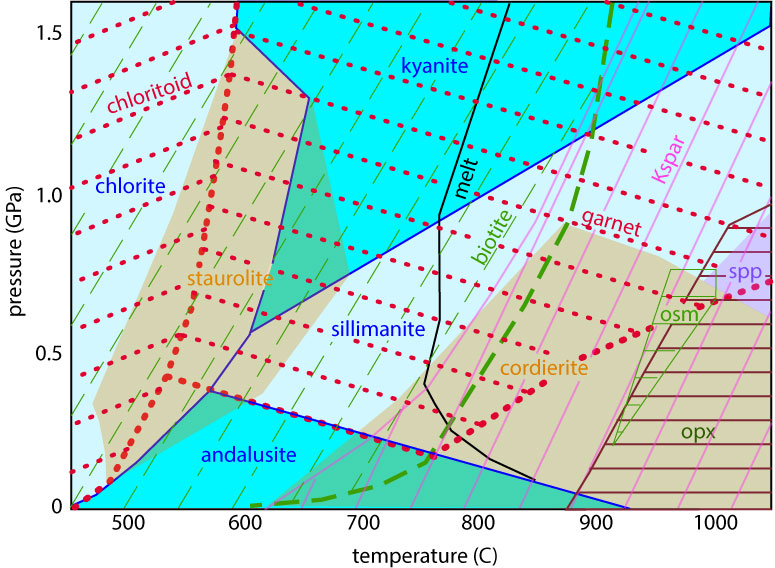
the presence of andalusite VIAlVAlSiO5 implies low P metamorphism
kyanite VIAlVIAlSiO5 implies high P
sillimanite VIAlIVAlSiO5 implies high T. Sillimanite first grows as fibrolite, a fine-grained acicular form:
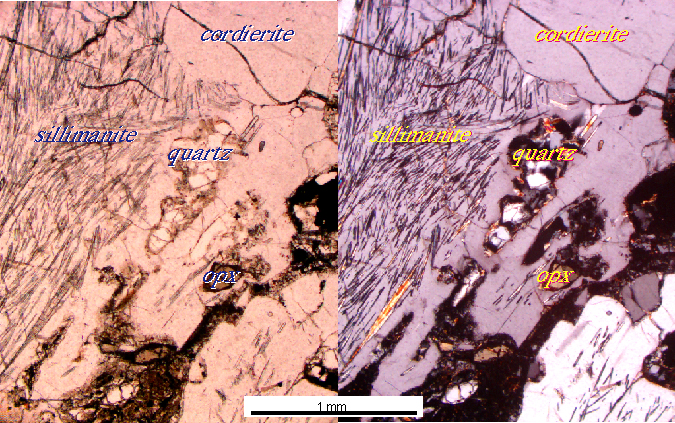
chlorite MgFeAlSiO(OH)x implies low T
biotite K(Mg,Fe)AlSi3O10(OH)2 implies moderate T
garnet implies moderate T
staurolite MgFeAlSiO(OH)x implies moderate-high P
chloritoid MgFeAlSiO(OH)x implies moderate-high P
cordierite MgFeAlSiO(OH)x implies low P
paragonite NaAlSi3O10(OH)2 implies high P
The A(K)FM diagram is used to describe the phase relations of pelites
- To start, we assume excess SiO2, H2O, meaning that quartz/coesite and H2O are stable in all mineral assemblages.
- Then we assume that plagioclase is also stable and of an unknown, but unimportant, composition; by this we ignore the effects of Na and Ca.
- This results in a tetrahedron of A=Al2O3, K=K2O, F=FeO, M=MgO:
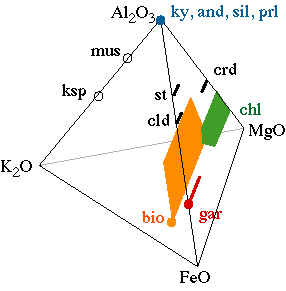
- To render this diagram in easier-to-understand-and-draw 2D, we project the compositions in the tetrahedron from muscovite KAl3Si3O10(OH)2 onto the AFM plane
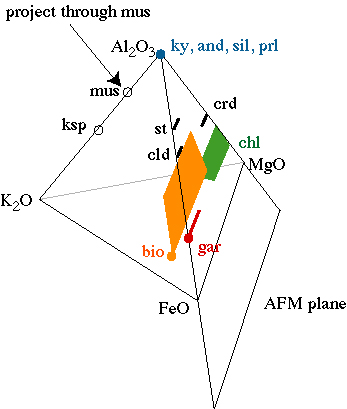
- This results in a common pelitic assemblage such as st + gar + bio + mus + plg + qtz + H2O (7 phases) plotting as a triangle. This is convenient, and possible only because we have assumed that i) qtz + H2O are in excess, ii) plagioclase is present, and iii) muscovite of fixed composition is present.
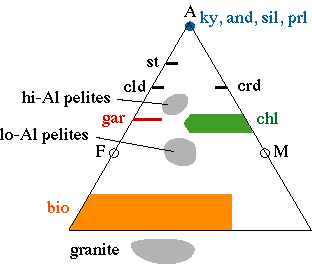
Metamorphic Zones
Barrovian metamorphic zones are defined by reactions that result in the appearance or disappearance of minerals and can be mapped as isograds
chl —> bi —> gar —> st —> ky —> sill —> sill + or
| Barrovian zone | mineral assemblage |
| chlorite zone |
chlorite + mus + qtz + H2O + relict minerals |
| biotite zone |
chlorite + biotite + mus + qtz + H2O |
| garnet zone |
chlorite + biotite + garnet + mus + qtz + H2O |
| staurolite zone |
staurolite + 2 AKFM phases + mus + qtz + H2O |
| kyanite zone |
kyanite + 2 AKFM phases + mus + qtz + H2O |
| sillimanite zone |
garnet + biotite + sillimanite + mus + qtz + H2O |
2nd sillimanite zone or
sillimanite + orthoclase zone |
sill + or + qtz + H2O + melt and no mus |
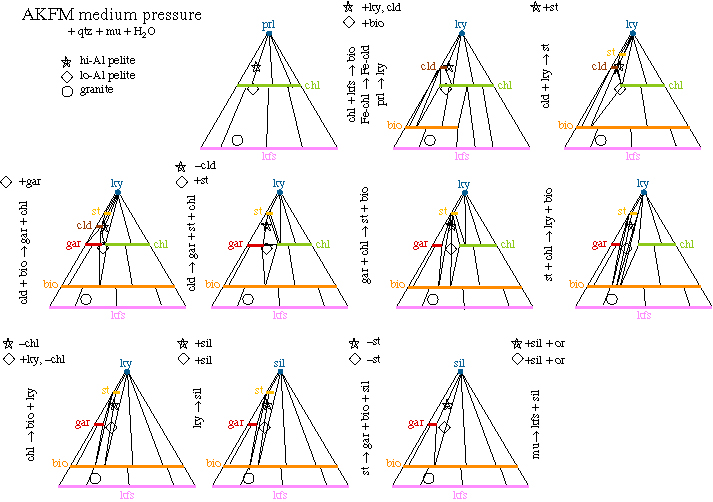
This development of metamorphic mineral assemblages corresponds to this P-T path:

Below is an example showing the prograde metamorphism of pelites around the Kangmar Dome of Tibet.
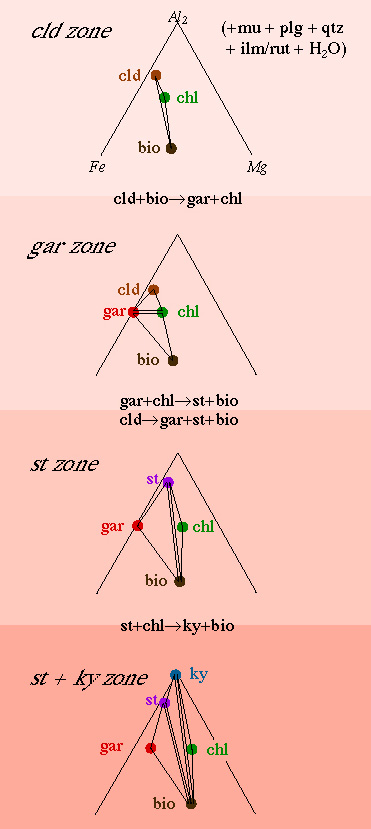
View the AFM movies #1 and #2 of Worley and Powell showing how mineral compositions and stabilities can change with changing temperature.
Part 1. Overview of Metamorphism and Tectonics
Part 2. Introduction to Metamorphism
Part 3. Physical Processes of Metamorphism
Part 4. Introductory Phase Equilibria and Thermodynamics
Part 5. Ultramafic Rocks
Part 6. Mafic Rocks
Part 7. Pelitic Rocks
Part 8. Diffusion
Part 9. Thermobarometry
Part 10. Kinetics
Part 11. Interaction Between Metamorphism and Deformation
Part 12. Metamorphism and Geochronology
Part 13. Metamorphism and Tectonics I
Part 14. Metamorphism and Tectonics II
Thermodynamics Notes







